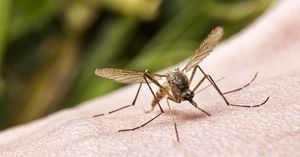The UK military has made significant strides with the launch of its first Earth-imaging satellite, named Tyche. Launched on August 16, 2024, from Vandenberg Space Force Base, California, on a SpaceX Falcon 9 rocket, this satellite signals a new era for Britain's capabilities in space.
Tyche is equipped to capture daytime images and videos of the Earth, supporting military operations, environmental monitoring, and disaster management. With its larger goal, the satellite aims to integrate with an upcoming constellation of satellites, enhancing the UK's intelligence, surveillance, and reconnaissance (ISR) capabilities.
The Ministry of Defence (MoD) views this launch as the first step toward bolstering the UK's military satellite program. According to Maria Eagle, Minister for Defence Procurement, "Tyche will provide critical intelligence for military operations and support various government tasks."
Maria Eagle also highlighted the UK's commitment to advancing technology and innovation through the program. This launch is pivotal for employment, too, having supported around 100 skilled jobs at Surrey Satellite Technology Limited (SSTL) since 2022.
Designed to operate for at least five years, Tyche has entered Low Earth Orbit, where it will provide timely imagery for military use. This capability is particularly timely, as the MoD has acknowledged the increasing importance of space for military operations, especially evident during recent conflicts like the war in Ukraine.
Tyche's design is similar to the size of a standard washing machine, weighing approximately 150 kilograms. Built on a £22 million contract with SSTL, this satellite is not only the first of the MoD's own kind but also represents the country's ambition to secure its own sovereign capabilities.
The satellite has specific imaging capabilities, able to identify objects on the ground as small as 90 centimeters. This resolution is not as sharp as some classified satellites, which can see objects down to 10 centimeters, yet it suits the British military's operational needs.
Major General Paul Tedman of UK Space Command remarked, "This is a fabulous day for UK space." He emphasized this launch marks the start of the UK’s endeavor to become a significant space power, with future launches planned over the next decade.
Looking forward, the MoD's strategy outlines potential future satellites equipped with various sensors, including those capable of night vision and radar imaging, which could drastically improve surveillance capabilities. These advancements are not only aimed at military operations but also encompass environmental oversight, showcasing Tyche's multifaceted potential.
Tyche was propelled to orbit as part of SpaceX's Transporter-11 mission. Early signals from the satellite confirmed its successful deployment shortly after lift-off, marking a celebratory milestone for the UK Space Command.
Paul Russell, the leader of the Defence Equipment and Support Space Team, described the satellite as the beginning of new military capabilities for the UK. He expressed pride over Tyche’s launch, representing collective commitment to advancing the MoD's objectives.
Tyche embodies the UK’s broader strategic goal post-2021, where new defense strategies began to outline stepping up investment and research efforts within its own space sector. The aim is to create self-sufficient capabilities rather than relying on collaborations with allies, which had been the norm until now.
With Tyche up and running, UK military personnel will have immediate access to critical imagery to inform their strategic decisions. The satellite's mapping capabilities will include helping track climate change impacts across various geographic areas.
Defense analysts note this advancement reflects broader trends of nations developing space capabilities for defense purposes. Even as global competition increases, the UK's dedication to enhancing its military options through technology remains strong.
"This is just the start of what we expect to be numerous satellites launched over the coming years," said Darren Jones, head of defence business at SSTL. The project has already stirred interest from international partners eager to establish similar capabilities.
Tyche serves as both innovation and utility; it’s set to contribute to scientific and military operations on multiple levels. Its sensors promise valuable insights, potential for collaboration with other nations, and long-term operational effectiveness.
Looking ahead, the UK aims to lead with capabilities reflecting the realities of modern warfare, where information possesses unprecedented value. This satellite is poised to be one of many steps toward achieving those ambitions.
Through Tyche, the UK has set the stage for expanded military space involvement, underpinned by commitments to fostering scientific growth and technological innovation. The coming years will reveal how Tyche and its successors will shape Britain's role as a formidable player on the global space frontier.



